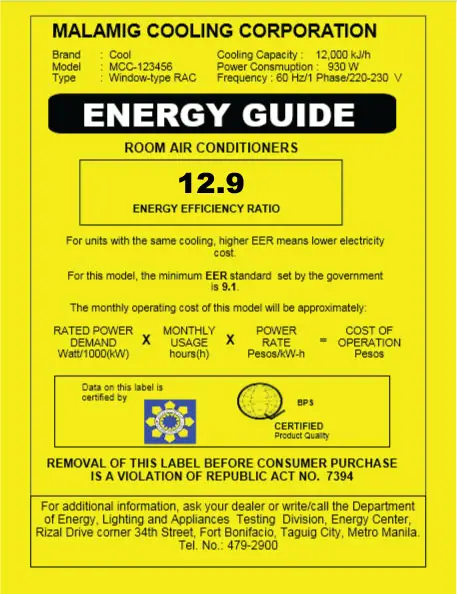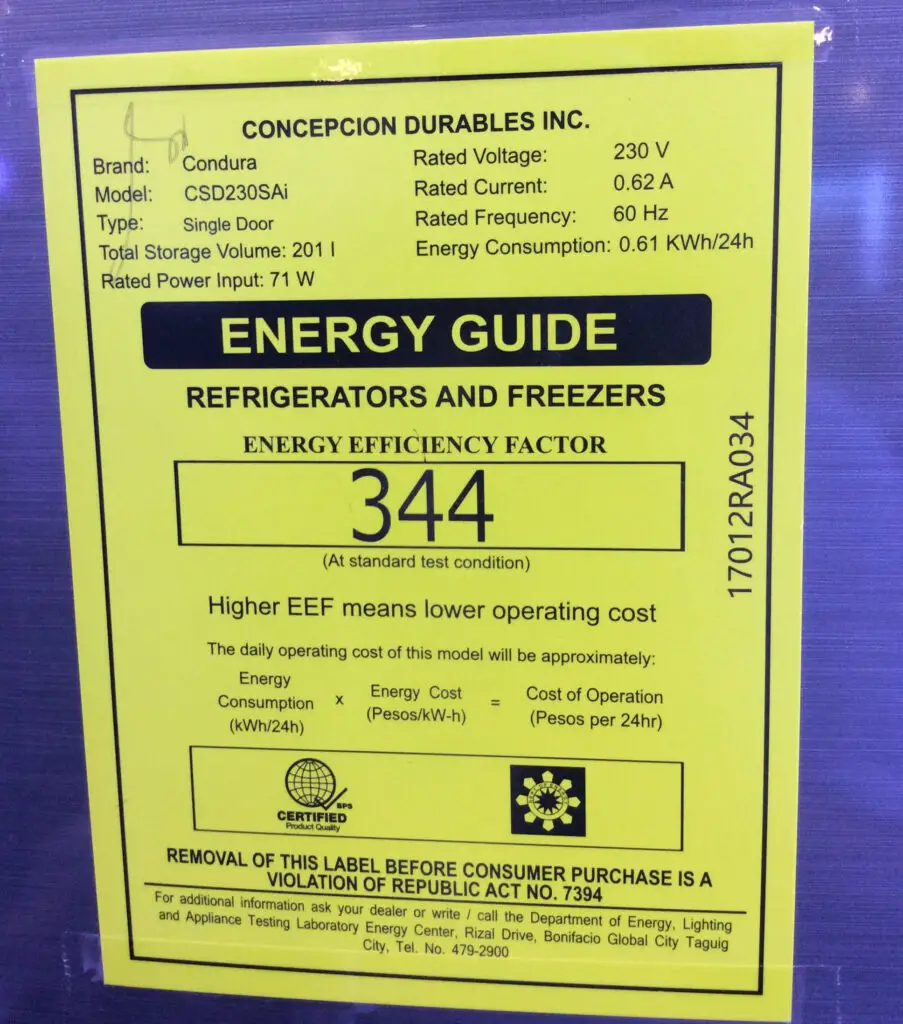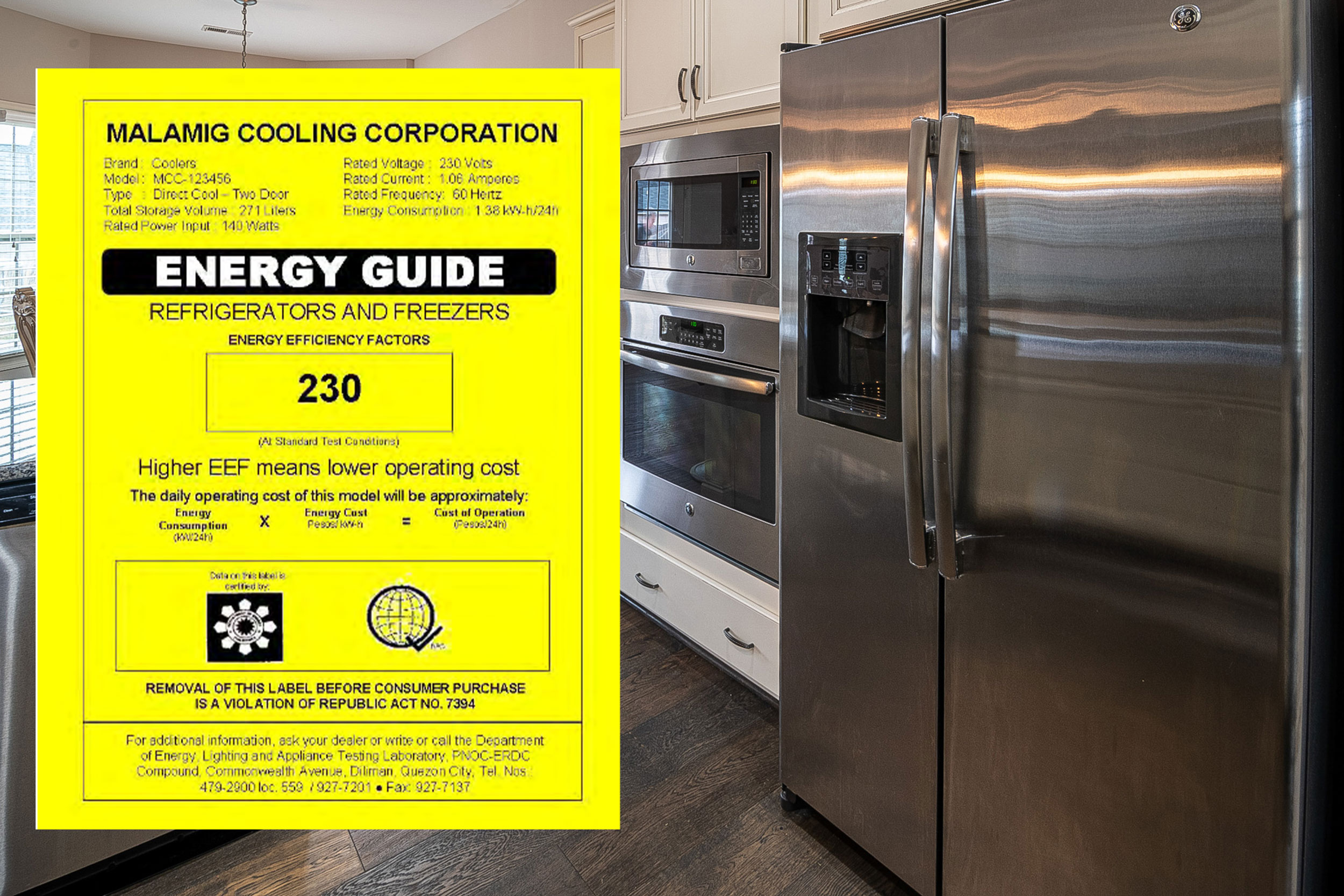Energy efficiency is one of the most important factors that you should take into account when buying a new refrigerator or a new air conditioner. The fastest and easiest way to tell if a model is energy efficient is by looking at how high its energy efficiency factor (EEF for refrigerators) or energy efficiency ratio (EER for aircons) is. These info is prominently displayed on its energy guide label.
Aside from showing the EEF or EER, the energy guide label also displays the model’s energy consumption. With this data, you can also estimate your daily and monthly savings (and it shows you how to compute for it too!)
What is the Energy Guide Label?
The energy guide label is a bright yellow piece of paper that displays the energy consumption and EEF/EER figures of a particular model. This will help you to easily compare the energy efficiency between different models in a store.

Aside from those, the energy guide label also displays the following data for the discerning buyer:
- Storage capacity (for refrigerators), or cooling capacity (for aircons)
- Minimum energy performance standard (MEPS)
- How to compute the operating cost of that unit
- PS or ICC marks
Note: The energy label goes by many names. People refer to it as either the EEF Label or EER Label, or just the Yellow Label.
What appliances have an energy guide label?
The energy guide label is seen on refrigerators, aircons, and lighting. However, not all models from these categories are included in that requirement.
For refrigerators, the models that are below 5.0 cu.ft. or above 20.0 cu.ft. are not required to have an EEF label. Beverage coolers, minibars, upright freezers, and chest freezers are similarly not required.
For air conditioners, only window air type conditioners are required to have an EER label; split type aircons and portable air conditioners are not required to have an EER label.
What does the Energy Efficiency Ratio (EER) for aircons mean?
The big number in the middle of the energy guide label of an air conditioner is its Energy Efficiency Ratio (EER).
The EER tells you how efficiently an aircon uses its power to cool the air. A high EER number means that that particular model is more energy efficient, and therefore has a lower operating cost.
While the EER value is certainly helpful, it won’t tell you how much it costs to operate the unit; it will only tell you which model is more efficient in relation to another model of the same category. Use the EER to quickly gauge the energy efficiency between similar capacity air conditioner models in a store.
How to calculate the EER of an aircon
The energy efficiency ratio can be computed by dividing the unit’s cooling capacity by its wattage.
Cooling Capacity: 12,000 kJ/h
Power consumption: 930W
12,000 ÷ 930 = 12.9 EER
You should also use the minimum EER standard as a comparison point. For this capacity of window type air conditioners, an EER of 9.1 is the absolute minimum; a 12.0+ EER rating for an air conditioner is very efficient.
What does the Energy Efficiency Ratio (EEF) for refrigerators mean?
The big number in the middle of the energy guide label of a refrigerator goes by a different name; instead of the EER, a refrigerator uses the Energy Efficiency Factor (EEF) instead.
However, the EEF and EER figures tell the same thing; The EEF tells you how efficiently a refrigerator uses its power to cool its rated storage volume.
As with the EER, a high EEF number means that that particular model is more energy efficient, and therefore has a lower operating cost. Use the EEF to quickly gauge the energy efficiency between similar refrigerator models in a store.
How to calculate the EEF of a refrigerator
A refrigerator’s Energy Efficiency Factor (EEF) is similar to the EER, but computed differently. To get the EEF, you should divide the total storage volume in liters by its energy consumption in kWh/24h.

Storage Capacity: 201L
Power consumption: 0.61 kWh/24h
201 ÷ 0.61 = 329 EEF
You may be wondering why the calculated EEF is different from the one displayed in the EEF label; this is because the Bureau of Philippine Standards (BPS) used the performance results of the model under a standard test condition.
This calculation is helpful at times when the EEF is not available for a particular category; chest freezers and high-capacity refrigerators come to mind.
How to compute the operating cost of a model using the Energy Guide Label
The EER and EEF value will help you easily decide which model is more efficient at a glance, but it will not tell you how much it will cost to operate that model.
Luckily, we can refer to the energy guide label to give us the computation to help us estimate the operating cost of a particular model.
How to compute the monthly electricity cost of an aircon
To compute the monthly electricity cost for air conditioners, we will use the following computation:
(Power Consumption/1000) x Hours of use x Power Rate = Daily Electricity Cost
For this example, we will estimate that the electricity rate in your area is ₱9.00/kWh. We will also be assuming that you will use your aircon for 8 hours everyday.

Since the power consumption figure is in watts (W) but the electricity rate is in kilowatt per hour (kWh), we need to divide the power consumption (930W) by 1,000. In this case, it’s 0.93 kWh. Now, we are ready to compute:
[wpdatatable id=2]
Do note that this is only an estimation. Other factors such as where the air conditioner is placed or how you use it will have an effect on your bill. If you want to find out the window type aircon model with the highest EER figure, go check it out here!
FURTHER READING: Where To Place Your Aircon For Better Energy Efficiency
How to compute the monthly electricity cost of a refrigerator
A refrigerator’s monthly electricity cost can be computed two ways using the energy guide label. First, we can use the kWh/24h figure already provided in the EEF label. We can also use the Rated Power Input figure (in watts) to calculate the kWh/24h figure.
These two paths lead to two different answers; one is lower, the other is higher. Treat these two sides as a range of the possible costs you can incur each month; your actual electricity cost being affected by your usage habits and where your refrigerator is placed.
Method #1 – using the kWh/24h value
Since a refrigerator is in use 24/7, the hours of use is naturally 24 hours; hence its energy consumption figure in the energy label is already in kWh/24h.
Energy Consumption (kWh/24h) x Power Rate = Daily Electricity Cost
We will use this example model from the BPS:

The given energy consumption is 1.38kWh/24h; we will also use ₱9.00/kWh as the power rate.
[wpdatatable id=11]
This method produces the lower-end of your cost range. To get the higher-end, use method #2:
Method #2 – using the rated power input
Since the rated power input is in watts, we have to divide it by 1000 to get its kWh value.
Using the same example, the given rated power input is 140W, which means that it is 0.14kW when converted. We need to multiply 0.14kW by 24 hours to get the kWh/24h figure we need for the calculation – that’s 3.36 kWh/24h.
(Rated Power Input/1000) x 24 Hours x Power Rate = Daily Electricity Cost
Here is the full computation:
[wpdatatable id=12]
This method produces the higher-end of your cost range. This means that depending on how you use your refrigerator or where you place it, this model will add somewhere between ₱372.6 – ₱907.2 on your electricity bill per month. If you want to find out the fridge model with the highest EEF figure, go check this article out!
Conclusion
With the ever-increasing cost of electricity, it is wise to invest in an energy-efficient appliance – it’s good for the environment too!
While choosing the most energy efficient model is certainly the way to go, you must not forget to control your usage and to keep an eye on the maintenance of your appliances to maintain their efficiency.

Miguel Mores worked for 5 years as a member of the product management team for a home appliance company in the Philippines. He started 101appliance to answer the most common customer questions that he has encountered during his time in the industry. He now works in the digital marketing field and manages a small online bookstore on the side.


this has been helpful!